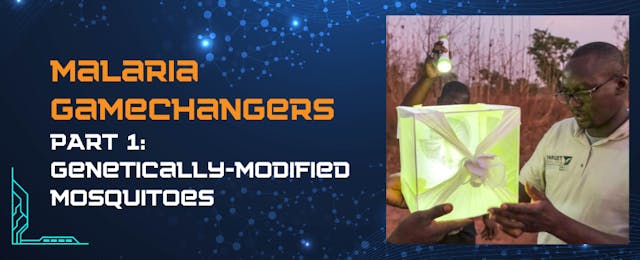

We’re excited to launch a new series, Malaria Gamechangers, that will highlight seven malaria innovations that are truly game-changing! From next-generation bed nets and anti-malarials to new vaccines and genetically-modified mosquitoes, these innovations are part of a promising pipeline of new tools and strategies that are expected to save lives and accelerate progress towards malaria eradication.
Part 1 of Malaria Gamechangers focuses on the efforts of Target Malaria, Imperial College London, and other partners who are working to reduce the population of malaria-carrying mosquitoes through gene drive technology. United to Beat Malaria’s Jonathan Kidwell interviewed Dr. Samantha O’Loughlin, Population Genetics Specialist at Imperial College London and Target Malaria, at the 2022 American Society of Tropical Medicine and Hygiene Annual Meeting in Seattle. You can watch the film and read the full interview below.
Dr. O’Loughlin: I am Samantha O’Loughlin, I am based in Imperial College London, and I’m part of the Target Malaria project, which is aiming to develop new and innovative vector control methods using genetically modified mosquitoes. I’m actually a scientist, a population geneticist, and I’ve been involved in the project for about 16 years. At the moment I’m working more with the stakeholder engagement side of things, but I still do some work on the population genetics of wild mosquitoes.
Mr. Kidwell: Why is the genetic modification of mosquitoes a gamechanger in the fight to eradicate malaria?
Dr. O’Loughlin: OK great great question. The idea of using genetically modified mosquitoes has been around for quite a long time because basically you’re using mosquitoes themselves to control malaria. So you’re not relying on things like a change in behavior of people for instance, when they have to sleep under bed nets. And you’re also not relying on things like the repeated application of insecticides. So the idea is that you would be able to release hopefully a small number of mosquitoes, and that they would spread some kind of genetic modification through the population and that would control the malaria.
Mr. Kidwell: And where is this gene drive technology currently being piloted?
Dr. O’Loughlin: It’s not actually being piloted at the moment, so it’s still in development in the labs. Target Malaria is working in Uganda and Burkina Faso, and we have partners out there who are starting to look at the mosquitoes that exist in that area and to build facilities for being able to work with genetically modified mosquitoes. In Burkina Faso, they have actually worked with some sterile genetically modified mosquitoes, but so far nobody actually has got gene drive technology in Africa. There are some other projects as well who are working in São Tomé and in Tanzania; but as yet, there aren’t any gene drive mosquitoes in Africa.
Mr. Kidwell: What is Target Malaria’s long-term goal, and what do you see as the roadblocks along the way to achieving that goal?
Dr. O’Loughlin: Our long-term goal is to have a strain of mosquitoes that would be an effective and safe tool to use for malaria control. So the actual mosquito strains that we’re looking at would have their fertility affected, which would mean they would reduce the number of wild mosquitoes in the population. And by reducing the number of mosquitoes, you reduce the amount of malaria. So that’s our long-term goal – is that we create this strain and then we can hand it over to the countries that wish to use it, and that they can incorporate it into their national malaria control programs.
As far as roadblocks: scientifically, we are very close to having a strain, so we’re very hopeful that we’ve got something in the lab that will be suitable for use. But then we have to go through all the correct regulatory processes and risk assessments. And basically, that’s going to take a while. So hopefully, once all that’s done, then we’ll be able to actually have this tool ready.
Stay tuned as we highlight a new Malaria Gamechanger each week throughout April and May!